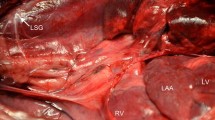Summary
Serotonin injected in the left atrium activates a cardiogenic hypertensive chemoreflex in dogs. To elucidate patterns of the neural traffic, records were obtained from thoracic sympathetic efferent nerves (either the anterior ansa of the left stellate ganglion or the T4 input to the left stellate) in 8 anesthetized dogs with chests open. Serotonin (200 μg, left atrium) caused a massive sympathetic discharge during the hypertension and bradycardia characteristic of the chemoreflex. Following the initial sympathetic discharge, there was a consistent post-excitatory depression of neural traffic, to a level significantly less than control discharge (two-tailed p≤.05). This post-excitatory depression began 11±5.4 (S.D.) seconds after injection of serotonin and 6.6±5.3 seconds after the peak neural discharge. It lasted 140±94 seconds, being maximal initially with gradual recovery. Complete block of the hypertension by the combined administration of phentolamine, propranolol, and nitroglycerin failed to abolish the efferent neural events, including postexcitatory depression, in all but one dog. We conclude that post-excitatory depression in thoracic sympathetic efferent neural traffic cannot be mediated exclusively through the secondary engagement of a baroreceptor mechanism and that it most likely is an integral part of the cardiogenic hypertensive chemoreflex.
Zusammenfassung
Serotonin bewirkt bei Injektion in den linken Vorhof von Hunden einen hypertensiven Chemoreflex. Um das Muster der nervalen Übermittlung zu klären, wurden bei 8 narkotisierten Hunden mit offenem Thorax Ableitungen von thorakalen sympathischen (efferenten) Nerven vorgenommen. Serotonin (200 μg) verursacht massive sympathische Entladungen während der Hypertension und Bradykardie, die für den Chemoreflex charakteristisch sind. Nach der initialen sympathischen Entladung kam es regelmäßig zu einer postexzitatorischen Depression auf ein Niveau, das eindeutig unter Kontrollbedingungen lag. Diese postexzitatorische Depression begann im Mittel 11 s nach der Serotoninjektion und durchschnittlich 6,6 s nach der neuralen Spitzenentladung. Sie dauerte im Mittel 140 s und erreichte initial maximale Werte mit allmählichem Rückgang. Komplette Blockierung der hypertensiven Reaktion durch kombinierte Verabreichung von Phentolamin. Propranolol und Nitroglycerin konnte die nervalen Vorgänge nicht beseitigen einschließlich der postexzitatorischen Depression (mit Ausnahme eines Hundes). Wir schließen daraus, daß die postexzitatorische Depression thorakaler sympathischer Efferenzen nicht ausschließlich durch die sekundäre Beteiligung eines Barorezeptormechanismus vermittelt werden kann. Sie gehört wahrscheinlich zum Wesen des kardiogenen hypertensiven Chemoreflexes.
Similar content being viewed by others
References
Eckstein, R. W., E. Shintani, H. E. Rowen, Jr., N. Ohya: Identification of left coronary blood supply of aortic bodies in anesthetized dogs. J. Appl. Physiol.39, 488 (1971).
James, T. N., J. H. Isobe, F. Urthaler: Analysis of components of a cardiogenic hypertensive chemoreflex. Circulation52, 179 (1975).
Urthaler, F., G. R. Hageman, T. N. James: Hemodynamic components of a cardiogenic hypertensive chemoreflex in dogs. Circulat. Res.42(1), 135 (1978).
Hageman, G. R., F. Urthaler, T. N. James: Neural pathways of a cardiogenic hypertensive chemoreflex. Amer. J. Physiol.235 (3), H345 (1978).
James, T. N., G. R. Hageman, F. Urthaler: Anatomic and physiologic consideration of a cardiogenic hypertensive chemoreflex. Amer. J. Cardiol.44, 852 (1979).
Urthaler, F., T. N. James, G. R. Hageman: Regional flow patterns during the serotonin-induced cardiogenic hypertensive chemoreflex. Cardiovasc. Res.14, 169 (1980).
James, T. N., F. Urthaler, G. R. Hageman: Reflex heart block. Amer. J. Cardiol.45, 1182 (1980).
Hageman, G. R., T. N. James, F. Urthaler: Clonidine attenuation of cardiogenic hypertensive chemoreflex. Hypertension3, 240 (1981).
Hageman, G. R., F. Urthaler, R. H. Swatzell, Jr., T. N. James: Analysis of sympathetic discharges during the cardiogenic hypertensive chemoreflex. Amer. J. Physiol.7, H61 (1980).
Sato, A., R. F. Schmidt: Somatosympathetic reflexes: afferent fibers, central pathways, discharge characteristics. Physiol. Rev.53 (4), 916 (1973).
Downie, N. M., R. W. Heath: In: Basic Statistical Methods. 3rd Edition, p. 178, 1970.
Simon, E., W. Riedel: Diversity of regional sympathetic outflow in integrative cardiovascular control: patterns and mechanisms. Brain Res.87, 333 (1975).
Pitts, R. F., D. W. Bronk: Excitability cycle of the hypothalamus-sympathetic neurone system. Amer. J. Physiol.136, 504 (1942).
Bronk, D. W.: Synaptic mechanisms in sympathetic ganglia. J. Neurophysiol.2, 380 (1939).
Rang, H. P., J. M. Ritchie: On the electrogenic sodium pump in mammalian nonmyelinated nerve fibres and its activation by various external cations. J. Physiol. (London)196, 183 (1967).
Polosa, C.: The silent period of sympathetic preganglionic neurons. Can. J. Physiol. Pharmacol.45, 1033 (1967).
Author information
Authors and Affiliations
Additional information
This work was supported by the National Heart, Lung and Blood Institute (Program Project Grant HL 11,310 and SCOR on Ischemic Heart Disease No. 1 P17 HL 17,667) and by the Philip B. Hoffman Fund. Dr. Hageman is the American Health Care Association Established Investigator of the American Heart Association.
Rights and permissions
About this article
Cite this article
Kilbourne, E.M., Hageman, G.R., James, T.N. et al. Post-excitatory depression in thoracic sympathetic efferent neural traffic during a cardiogenic hypertensive chemoreflex. Basic Res Cardiol 77, 423–430 (1982). https://doi.org/10.1007/BF02005342
Received:
Issue Date:
DOI: https://doi.org/10.1007/BF02005342




